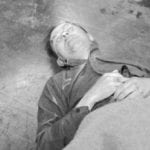 Miscellaneous
Miscellaneous  Miscellaneous
Miscellaneous  Our World
Our World 10 Green Practices That Actually Make a Difference
 Humans
Humans Ten Historic Men Who Deserve Way More Credit Than They Got
 Movies and TV
Movies and TV The 10 Most Heartwarming Moments in Pixar Films
 Travel
Travel Top 10 Religious Architectural Marvels
 Creepy
Creepy 10 Haunted Places in Alabama
 History
History Top 10 Tragic Facts about England’s 9 Days Queen
 Food
Food 10 Weird Foods Inspired by Your Favorite Movies
 Religion
Religion 10 Mind-Blowing Claims and Messages Hidden in the Bible Code
 Facts
Facts 10 Things You Never Knew about the History of Gambling
 Miscellaneous
Miscellaneous Ten Groundbreaking Tattoos with Fascinating Backstories
 Our World
Our World 10 Green Practices That Actually Make a Difference
 Humans
Humans Ten Historic Men Who Deserve Way More Credit Than They Got
Who's Behind Listverse?

Jamie Frater
Head Editor
Jamie founded Listverse due to an insatiable desire to share fascinating, obscure, and bizarre facts. He has been a guest speaker on numerous national radio and television stations and is a five time published author.
More About Us Movies and TV
Movies and TV The 10 Most Heartwarming Moments in Pixar Films
 Travel
Travel Top 10 Religious Architectural Marvels
 Creepy
Creepy 10 Haunted Places in Alabama
 History
History Top 10 Tragic Facts about England’s 9 Days Queen
 Food
Food 10 Weird Foods Inspired by Your Favorite Movies
 Religion
Religion 10 Mind-Blowing Claims and Messages Hidden in the Bible Code
 Facts
Facts 10 Things You Never Knew about the History of Gambling
10 Daredevil Scientists Who Turned Themselves Into Guinea Pigs
Sometimes, innovation comes with a steep price. We cannot always expect to gain new insights into ourselves or the world around us without sacrifice. The good news is that there have always been people willing to put themselves on the line for the advancement of all mankind.
10John Scott Haldane

Scottish scientist John Scott Haldane studied the physiology of breathing. He learned about the effects that various dangerous gases can have on the body and the mind, oftentimes by experimenting on himself (and sometimes his son). One such case took place in 1893, when he locked himself in an airtight box, affectionately named “the coffin,” and remained inside for eight hours. He breathed the same air over and over again and noted the effects this had on him. He discovered that deoxygenating the blood increases its capacity to carry carbon dioxide, a property known today as the Haldane effect.
Next up, he investigated dangerous gases in mines. He used small animals and discovered that the lethal culprit is carbon monoxide. Just to be sure, he also poisoned himself with carbon monoxide in an enclosed chamber to see if the effects were the ones expected. Eventually, he came up with the idea of using small animals (canaries, in particular) as gas detectors since their bodies were affected much faster.
When World War I broke out, the Germans started using poison gas as a weapon. Haldane was brought to the front line to identify the gas in question (chlorine) and to find a solution. Again, his own body was the first used for experiments, and his efforts led him to develop the first gas mask.
9David Pritchard

While working in Papua New Guinea during the late 1980s, Dr. David Pritchard made a few interesting observations regarding the locals. The Necator americanus parasite, commonly called the hookworm, was a problem for the population, but it had some unexpected positive side effects. Patients who were infected with the parasite were less likely to have problems with autoimmune-related illnesses, particularly asthma and hay fever.
When he got back home to Nottingham University, the doctor was keen to test out his idea and see if there was any real connection between the two factors. However, he had a problem. Hookworms are quite dangerous. Back then, they were responsible for 65,000 deaths in the tropics every year and hundreds of thousands of cases of anemia. The British National Health Service’s ethics committee wouldn’t allow him to use human test subjects unless they knew it was safe.
So Pritchard did the only thing he could do: He used himself as a guinea pig. He infected himself with 50 hookworms to develop a safe testing technique under lab conditions. He eventually concluded that all subsequent participants should be infected with just 10 parasites—enough to yield good data without endangering them. It wasn’t until 2006 that the National Health Service finally allowed him to conduct a study using human subjects.
8Moran Campbell

Dr. Moran Campbell was a leading researcher into respiratory problems and inventor of the Ventimask, a product still used today. While he studied all aspects of breathing, his experiments regarding dyspnea are worth mentioning here.
Dyspnea is the shortness of breath that we experience when our breathing is impaired. In certain situations, like heavy physical exercise, it is normal. However, dyspnea also appears plenty of times when it shouldn’t, and Campbell wanted to see exactly what the connection was between the condition and the respiratory muscles.
To do so, he came up with an experiment to test his own respiratory muscles under extreme conditions. For starters, he paralyzed his entire body except for his forearm using curare, a common toxin used for poison darts and arrows. This way, he would not be able to control his body movements, but he also would be completely awake for the whole experiment. Afterward, Campbell was hooked up to a respirator since he was unable to breathe on his own. Then the respirator was turned off. The next few minutes involved Campbell slowly suffocating to see how his body would react.
The experiment wasn’t even particularly useful. By his own admission, Campbell later stated that being paralyzed using curare (or curarized, as he put it) was nothing like paralysis through prolonged or ischemic contraction.
7Horace Wells

As Dr. Campbell showed, not every self-experiment has a positive, definitive result. However, things can sometimes get even worse, like in the case of Horace Wells, a dentist who was among the first to introduce the use of anesthesia in dentistry. Specifically, he pioneered the use of nitrous oxide (laughing gas) as a painkiller to be used during tooth extraction. To test the efficacy of the gas, he used it as anesthesia and had one of his own teeth extracted.
The process proved to be quite successful at first, and Wells performed several more extractions with no complications. Afterward, he felt it was finally time to take his show to the big time. He scheduled a demonstration at Massachusetts General Hospital, but the gas was not administered properly, and his patient started howling in pain.
Now a disgraced dentist, Wells moved to Europe to continue his research. When he returned to America, Wells discovered that nitrous oxide was out, and ether and chloroform were in. So he started experimenting with chloroform the best way he knew how—on himself. Unfortunately, back then, the effect of prolonged chloroform exposure wasn’t known yet. After inhaling the gas for a week, Wells went quite mad. At one point, he threw a container of sulfuric acid on two prostitutes. This got him thrown in prison.
When his mind finally returned, he was so overcome with guilt that he committed suicide.
6Maurizio Montalbini

We humans function using a circadian rhythm. We are active during the day, and our internal biological clock is based on a 24-hour timeframe thanks to external stimuli. But what would happen if there were no external signals? That was the question posed by sociologist Maurizio Montalbini. To answer it, he had to be completely isolated—so he went to live in a cave for a few years.
He first did this in December 1986. He spent seven months in the Frasassi Caves, breaking the world record for complete isolation in the process. He repeated this experiment two more times—once in 1992 and once in 2006. He spent a full year and 260 days, respectively, isolated in a cave.
As Montalbini showed, the human body and mind change once there are no external factors to offer information regarding the time of day or the passage of time. First of all, time started going by much faster for him. Montalbini always thought he spent far less time in the caves than he actually did. He lost around 14 kilograms (30 lb) the first time he did this. His body got used to staying awake for 50 hours at a time and then going to sleep for five.
5Lazzaro Spallanzani

Not all experiments have to be dangerous. Some of them are just plain weird (and a little bit gross). Take Lazzaro Spallanzani. The 18th-century Italian biologist studied a variety of topics, including echolocation and biogenesis. However, it is his work researching bodily functions that earns him a place here.
We learned a lot about digestion thanks to Spallanzani. Up until his time, the accepted truth was that digestion was a purely mechanical process called trituration. He showed us that a chemical reaction was involved. Specifically, he demonstrated the process of food being broken down by gastric juices in the stomach. He used a variety of animals for his experiments. To obtain gastric juice samples, he either made the animals throw up or shoved a sponge tied to a cord down their throats.
On other occasions, he wanted to see the effects of gastric juices on food at various stages. This was either done through regurgitation, passing the food naturally, or slicing the animal open to retrieve the stomach contents. Afterward, he would note any changes in the food samples, such as weight loss.
He performed these experiments on a variety of animals . . . and one human: himself. He would swallow samples wrapped in linen bags or wooden tubes and regurgitate them after a delay. When the need arose, he would swallow the same sample more than once.
4Jack Barnes

About 50 years ago, Australia was dealing with a dangerous condition called Irukandji syndrome. It caused headaches, nausea, vomiting, and abdominal pains. Left untreated, it could even be fatal. To treat it, first we had to know what caused it, and Dr. Jack Barnes thought he had a pretty good idea—the box jellyfish.
Nowadays, we know that many species of box jellyfish are among the deadliest creatures on the planet, so we avoid them at all costs. But Dr. Barnes captured the jellyfish in question, a tiny critter about 2.5 centimeters (1 in) in diameter, and let it sting him to see if he developed Irukandji syndrome. Not content with just one test subject, he also stung his son and a local lifeguard, just to be sure.
All three got sick and had to be taken to the hospital, where they made a full recovery. The tiny jellyfish was indeed the culprit that caused all the trouble and was later named Carukia barnesi in Barnes’s honor. Later, it would be discovered that several other species of jellyfish can also cause Irukandji syndrome.
3Donald Unger

Donald Unger was once a kid who, like many of us, got repeatedly scolded by his mother for cracking his knuckles. She warned him that this would cause arthritis, and he eventually found himself in a position where he could put this claim to the test. Each day, he would crack the knuckles on just his left hand and not the right. He wanted to see if there was any noticeable difference at the conclusion of the experiment.
At first, this doesn’t sound particularly crazy or bizarre—just cracking your knuckles every day. However, what is unique is the length of the experiment: 60 years.
For six decades, Dr. Unger stuck to his routine to see if knuckle cracking does, indeed, cause arthritis. When he finally put an end to his test, he took comprehensive X-rays of his hands and found no significant difference between them. For his efforts, Dr. Unger was awarded the Ig Nobel Prize in Medicine in 2009.
2Jesse Lazear

Yellow fever is still one of the most dangerous illnesses affecting mankind, but it used to be much worse. In 1900, a group of four scientists dubbed the Reed Commission was tasked with studying the condition. Back then, we didn’t even know for sure what caused yellow fever. General consensus said that the disease was transmitted through direct contact, but not everyone was convinced. So the four men moved to Cuba, a breeding ground for the virus, and got to work.
Among those men was young doctor Jesse Lazear, who specialized in tropical diseases like yellow fever and malaria. A British scientist by the name of Sir Ronald Ross had just discovered that malaria was transmitted by mosquitoes, so Lazear entered the Commission fairly certain that mosquitoes were responsible for yellow fever as well. He wasn’t the first to think this. Cuban scientist Carlos Juan Finlay had had the same idea. However, where Finlay’s experiments failed, Lazear’s would succeed.
“I rather think I am on the track of the real germ,” wrote Lazear to his wife. Just 17 days later, he was dead. And that is because, unbeknownst to his colleagues, Lazear had allowed himself to be infected with yellow fever to establish the link between it and mosquitoes.
His sacrifice was not in vain, as his work was a crucial step in finding a treatment for yellow fever.
1Henry Head

Dr. Henry Head was an English neurologist who performed pioneering work studying the somatosensory system. He focused in particular on nociception, which is the sense of pain. He started off by using recovering patients with nerve damage as test subjects. However, he quickly found out that their lack of medical knowledge kept him from the kind of accurate, objective answers he required from his volunteers. So he found a better test subject—himself.
There was just one problem. He didn’t have any nerve damage to observe. Easy fix—one quick surgery and two severed nerves in Head’s left forearm, and the problem was solved.
Dr. Head then spent the next four years documenting his recovery. Each weekend, he traveled to his colleague’s room at Cambridge and underwent an examination of his affected and unaffected arms to note the differences.
Head carefully tracked all of the sensory changes he was experiencing once his radial nerves were transected. He eventually went on to become among the first to talk about sensory dissociation by speculating about the existence of two different sensory systems, which he called the epicritic and protopathic systems.
Radu is a history/science buff who writes for GeeKiez when he isn’t writing for Listverse.








